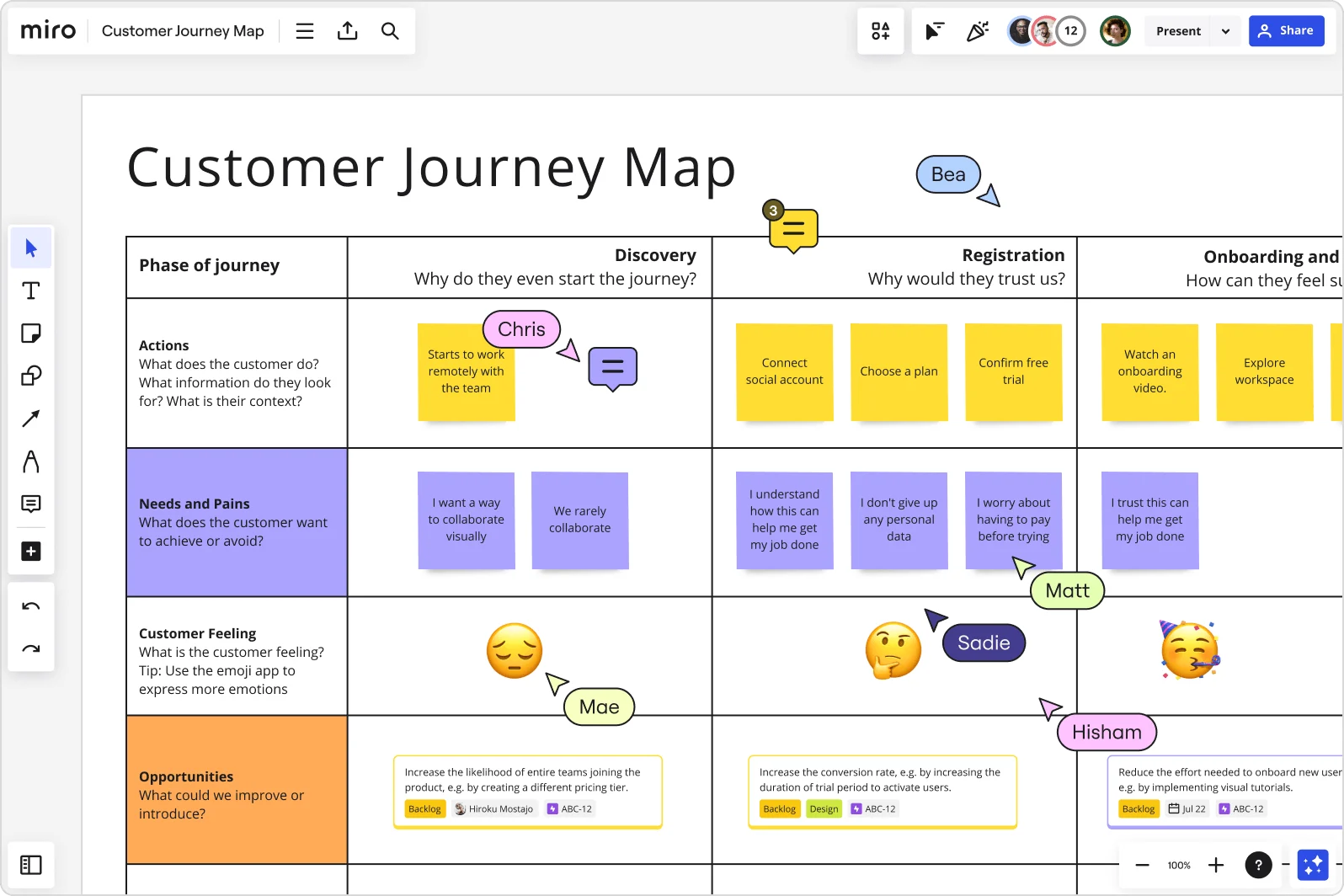
Table of contents
Table of contents
Service blueprint vs. journey map

Summary
In this guide, you will learn:
- Key differences & similarities between service blueprints & customer journey maps
- When to use each tool based on goals & focus
- Main components of a service blueprint & their roles
- How journey maps focus on customer emotional experience
- How service blueprints include customer-facing & behind-the-scenes processes
- Practical examples of how these tools complement each other
Understanding Journey Maps
A journey map is a visual representation of a customer's experience with a product or service over time. Creating a customer journey map is pivotal in business because it enables a comprehensive understanding of the customer's perspective, encompassing interactions, emotions, and pain points. A journey map consists of stages, touchpoints, and channels, and may be used in real-world scenarios like understanding the user experience on an e-commerce platform.
Understanding Service Blueprints
A service blueprint, on the other hand, is a tool used to visualize the service delivery process from the customer's and service provider's perspectives. It is essential in a business context as it aids in identifying potential problem areas in service delivery. Components of a service blueprint include customer actions, frontstage and backstage interactions, and support processes.
For example, a restaurant may use a service blueprint to streamline its order and delivery process. You can refer to one of our service blueprint templates for an illustrative example demonstrating how the service delivery process can be effectively visualized.
Try Miro now
Enhance customer experiences with Miro's Journey Mapping tools for clear visualization.
Service blueprint vs. journey maps and their importance
Journey maps and service blueprints are important tools for any profession that requires a deep understanding of customer experiences and the intricacies of service delivery.
They are especially valuable for those in roles related to customer experience management, product or service development, and process optimization. For instance, UX/UI Designers, Customer Experience Managers, Service Designers, and Product Managers frequently use these tools to understand and enhance user interactions with their products or services. Additionally, Business Analysts and Process Improvement Specialists use service blueprints to visualize and improve service delivery processes.
Service blueprints vs. journey maps: similarities
While journey maps and service blueprints each have their unique attributes, they share key similarities that reinforce their value in enhancing customer experience and service delivery.
- Customer-centricity: Both tools center around optimizing the customer's experience with a product or service.
- Visual representation: They use graphical elements to simplify complex interactions and processes.
- Holistic approach: Each offers a comprehensive view of the customer journey or service process.
- Basis for improvement: They highlight gaps and inefficiencies to guide service improvement initiatives.
- Cross-functional collaboration: Both tools promote teamwork across departments within an organization.
Customer journey maps vs. service blueprint: differences
In understanding the nuances of a customer journey map vs. service blueprint, their key differences highlight their unique applications:
Perspective: A journey map zeroes in on the customer's perspective, while a service blueprint covers both the customer's viewpoint and backstage service delivery processes.
Focus: Journey maps trace the customer's experience over time, whereas service blueprints offer a comprehensive snapshot of the entire service process.
Service blueprints vs journey map: when to use them
Use a journey map when you need to understand the customer's emotional journey, needs, and pain points. When you want to optimize the whole service delivery process, considering both customer interactions and the behind-the-scenes activities, use a service blueprint.
Miro has both a customer journey mapping template and a service blueprint templates that can help you get started. Want to see in practice? Check out how Maureen, Product Designer at Miro, deep dives into understanding users' experiences, working hand in hand with them to sketch out their journey. All within the platform. She'll share the details of how she and her team brainstorm ideas to tackle insights they uncover — and craft a practical plan to move forward.
Service blueprints vs journey map: benefits and limitations
Journey maps excel in providing insights into customers' emotions and experiences, while service blueprints provide a comprehensive view of the service process. However, journey maps might lack the details of the delivery process, and service blueprints might not capture the emotional aspect of the customer experience.
Questions to consider
When should my business use a journey map over a service blueprint? A business should use a journey map when the goal is to understand the customers' experiences, emotions, and interactions at each touchpoint.
Can journey maps and service blueprints be used together? Yes, journey maps and service blueprints can be used together to provide a comprehensive view of the customer experience and the service process.
What are some common mistakes to avoid when creating a journey map or a service blueprint? Common mistakes include not involving all stakeholders, not considering the customer's perspective, and overlooking important steps in the service process.
How often should my business update its journey map and service blueprint? The frequency of updates depends on changes in the business environment, customer behavior, or service process. However, regular reviews are recommended for continued relevancy.
Author: Miro Team
Last update: October 7, 2025